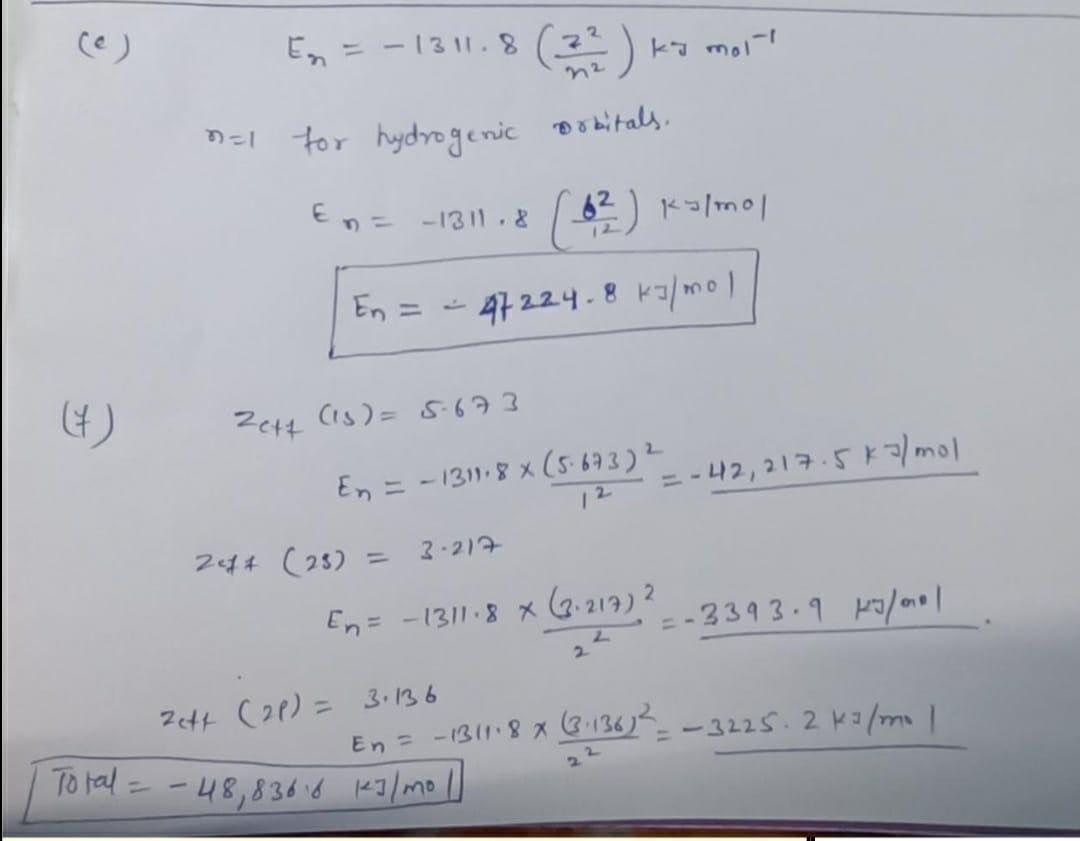(e) Estimate the total energy of a carbon atom by adding the energies of the populated hydrogenic orbitals using Z = 6. Report your answer in eV and al (attojoules). (f) Estimate the total energy of a carbon atom by adding the energies of the populated hydrogenic orbitals but replace Z with Zer(1s) = 5.673, Ze(2s) = 3.217, and Zen(2p) = 3.136. Report your answer in eV and al (attojoules).
(e) Estimate the total energy of a carbon atom by adding the energies of the populated hydrogenic orbitals using Z = 6. Report your answer in eV and al (attojoules). (f) Estimate the total energy of a carbon atom by adding the energies of the populated hydrogenic orbitals but replace Z with Zer(1s) = 5.673, Ze(2s) = 3.217, and Zen(2p) = 3.136. Report your answer in eV and al (attojoules).
Physical Chemistry
2nd Edition
ISBN:9781133958437
Author:Ball, David W. (david Warren), BAER, Tomas
Publisher:Ball, David W. (david Warren), BAER, Tomas
Chapter12: Atoms And Molecules
Section: Chapter Questions
Problem 12.12E: Are mathematical expressions for the following potential energies positive or negative? Explain why...
Related questions
Question
do this

Transcribed Image Text:Do E and F only
1. Let's consider the carbon atom using the orbital approximation.
(a) Write the ground-state electron configuration for a carbon atom.
(b) Draw an orbital energy diagram showing how electrons (with spin) occupy orbitals.
(c) Explain how you used the Pauli exclusion principle in (a).
(d) Explain how you used Hund's rule in (a).
(e) Estimate the total energy of a carbon atom by adding the energies of the populated hydrogenic
orbitals using Z = 6. Report your answer in eV and al (attojoules).
(f) Estimate the total energy of a carbon atom by adding the energies of the populated hydrogenic
orbitals but replace Z with Ze(1s) = 5.673, Zet(2s) = 3.217, and Zen(2p) = 3.136. Report your answer in
ev and al (attojoules).
Expert Solution
Step 1

Step by step
Solved in 2 steps with 1 images

Knowledge Booster
Learn more about
Need a deep-dive on the concept behind this application? Look no further. Learn more about this topic, chemistry and related others by exploring similar questions and additional content below.Recommended textbooks for you

Physical Chemistry
Chemistry
ISBN:
9781133958437
Author:
Ball, David W. (david Warren), BAER, Tomas
Publisher:
Wadsworth Cengage Learning,

Chemistry: Principles and Practice
Chemistry
ISBN:
9780534420123
Author:
Daniel L. Reger, Scott R. Goode, David W. Ball, Edward Mercer
Publisher:
Cengage Learning

Physical Chemistry
Chemistry
ISBN:
9781133958437
Author:
Ball, David W. (david Warren), BAER, Tomas
Publisher:
Wadsworth Cengage Learning,

Chemistry: Principles and Practice
Chemistry
ISBN:
9780534420123
Author:
Daniel L. Reger, Scott R. Goode, David W. Ball, Edward Mercer
Publisher:
Cengage Learning